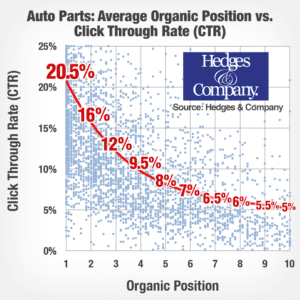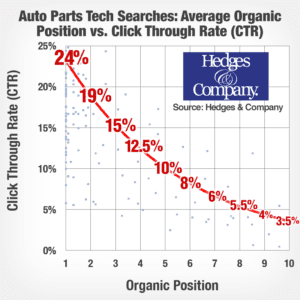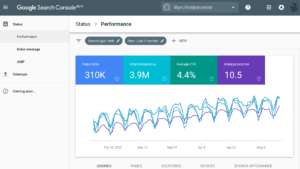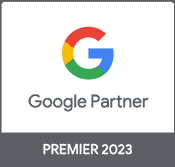Auto Parts Keyword List for SEO (2024)
Are you trying to compile an auto parts keyword list for your SEO? As you may know, we recommend using our EAST acronym and Google’s E-A-T to optimize web pages.
Auto parts keywords for your #SEO: get your #autoparts website ranking higher with these tips Click To TweetStill, it’s important to know how auto parts keywords play a role. We do extensive testing and experimenting on what works best for SEO. We also do our own case studies on consumer search patterns and analysis of keywords. Here are some of our best SEO strategies to build out your own auto parts keyword list.
Tips on building your auto parts keyword list:
- The Road to Purchase is sometimes non-linear. You need to be visible for different types of search keywords along the Road to Purchase
- Your auto parts SEO strategy should include analyzing click through rate (CTR) vs. organic ranking
- There’s a gold mine of auto parts keywords data waiting for you in your Google Search Console account
- Get organized and create a list of search topics
Any auto parts marketing strategy should include an analytical look at keyword search terms. It’s not easy to do and it’s not a set-it-and-forget-it activity. To be really effective, you have to work on SEO every day.
Look for auto parts keywords with high click through rates
You probably already know web pages that rank higher have better click through rates (CTRs). But, do you know how much better?
Our analysis of CTR vs. ranking echos many other SEO studies, like this one, but we don’t know of a more comprehensive study done specifically on auto parts SEO keywords.
For this case study, we analyzed over 7,000 auto parts keywords for their rankings on Google and compared their CTR.
We found the #1 ranked keywords had a 310% higher click through rate than words that were ranked at #10.
Automotive keywords ranked at #1 have an average CTR of 20.5% but keywords ranked #10 only had an average 5% CTR.
#autoparts keywords ranked #1 have an average click through rate of 20.5%, from a @HedgesCompany study of over 7,000 keywords. Click To Tweet There’s a quick drop-off in click through rate from #1 to #2, where the second-ranked keywords have a 16% CTR.
Just going from the second organic position to #1 can improve your CTR an average of 28%. That’s pretty amazing!
Don’t forget tech terms in your parts keyword list
We also looked at automotive parts technical searches and their organic rankings vs. CTR.
What we found was a little surprising.
Technical auto parts searches are terms like “how do I…“, “what does a…“, or searches for specific tech information like a wheel bolt circle diameter or engine firing order.
These can be search terms like “How do I change spark plugs in a 2017 Mustang?” or “What does a reverse rotation turbocharger do?”
The benefit of ranking #1 for technical auto parts searches has an even stronger relationship to CTR. Technical automotive search terms with a #1 ranking had an average click through rate of 24%, even higher than the example in the first graph above.
Technical automotive search terms that were ranked #1 had a 585% higher CTR than technical search terms ranked #10.
This is an important strategy: Include automotive technical search terms in your auto parts keyword list.
Look at your Google Search Console keywords
To first understand what’s working or not working on your own website, and within your current auto parts SEO strategy, it helps to dig into Google Search Console. All your current, relevant auto parts keywords are in there.
Some people don’t pay enough attention to Google Search Console. If you haven’t looked at it, or even haven’t looked recently, it’s a great tool.
Here are some quick tips to get the most out of your own keyword data. It’s just sitting there, waiting for you to download it.
Log into your Search Console account and you’ll see a page something like the one shown here.
Once you go to Google Search Console go to Performance > Search results and you’ll see the default graph for the past three months with Total Clicks (blue) and Total Impressions (aqua) highlighted. Add Average CTR (green) and Average Position (purple).
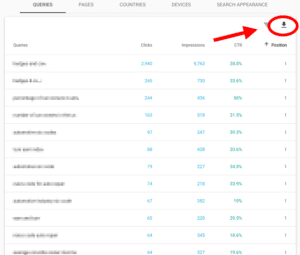 Next, click the download icon as shown at the left (arrow pointing down). This lets you download a file (.csv or Excel) that you can open and see valuable data for your SEO efforts.
Next, click the download icon as shown at the left (arrow pointing down). This lets you download a file (.csv or Excel) that you can open and see valuable data for your SEO efforts.
You’ll get all the organic search terms that shoppers clicked on to visit your site, terms your site showed up for whether they resulted in a click or not (impressions), the average position for those search terms and the average click through rate for each search term.
Pro tip: Download this keyword data on a regular basis to track it over time.
Of course, with the new Search Console you have more flexibility on time ranges, compared to the old Search Console, which is a nice benefit of the new platform. You can go back farther than the default three months.
This type of data also lets you create the type of scatter charts that we show above, too, so you can look at your average organic rankings vs click through rate. We made that in Excel using a simple download of data like we’re describing, from Google Search Console.
Of course, this process doesn’t show what your competitors are doing in their SEO strategies – there are some third party SEO tools either free or paid for that type of research – but we really like Google Search Console as a free SEO tool.
As a side note, Google Search Console also helps you monitor your Core Web Vitals, which are changing again in 2024.
Auto parts keywords: Create a list of topics
You need to focus and do research to be really effective at marketing your website. It helps to create a list of topics that are important to your SEO efforts.
And if you’ve been following the latest trends on automotive SEO you already know, topics actually beat keywords.
This organized approach keeps you focused, helps manage your efforts, and makes it easy to track your SEO work over time. You have to have an organized approach to data used for SEO otherwise it’s easy to get overwhelmed and off track.
Creating an organized list of topics, and keywords within those topics, allows you to create a structured plan for your auto parts SEO campaign. If you truly want your website to succeed, having a plan will always get you better results than flying blind.
After all, doesn’t data drive everything we do in the automotive aftermarket?
Understanding the Road to Purchase
The auto parts Road to Purchase is a winding one and its commonly accepted that shoppers take some type of path before purchasing. You should know what the automotive parts Road looks like before even starting your auto parts SEO strategy.
The Road to Purchase for car parts can vary a lot, depending on what part you’re optimizing for. For example, when a shopper needs an OEM part, it’s usually because something broke or wore out. It may not be a planned purchase.
The Road to Purchase for car parts varies a lot and you need an #SEO strategy to show up for potential buyers all along the Road. Click To TweetBut, for a performance car part, an accessory, or something to customize a vehicle, the shopper may have been thinking about that part for weeks, months or even years.
The Road for these different kinds of parts can be wildly different, and your auto parts SEO strategy needs to be both adaptable and scalable in order to reach all kinds of potential buyers.
Look at the Road to Purchase and you can see SEO requirements change as a shopper moves along the Road. It may start with interest in a certain part without details. It may involve looking at forums for more ideas. The searches used on Google at this point can be vague and generic.
A car parts shopper may then look at manufacturer websites to verify fitment or see an entire product line. We reported in the August 2016 issue of PWA Newsline (now Custom Automotive Network) that nearly three out of five of shoppers visit manufacturer websites. In the October 2016 issue we reported they are looking for detailed product information and verifying fitment.
As the shopper travels down the Road to Purchase, the search activity gets more specific with keywords that show high purchase intent, like “where to buy…” or very specific fitment queries.
What did you think? Was this a helpful blog post? Let us know, and get started building your list of keywords!

